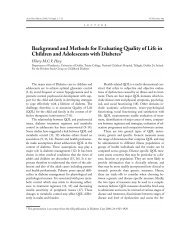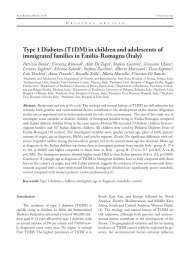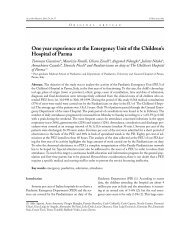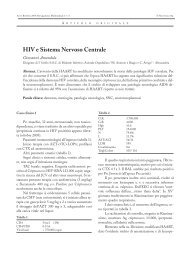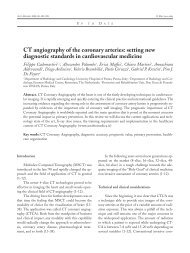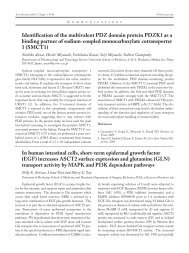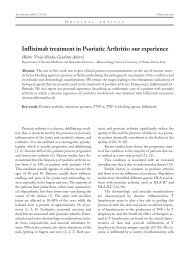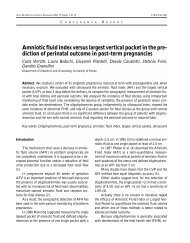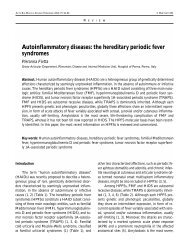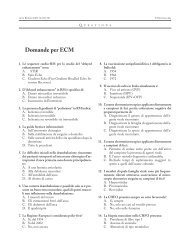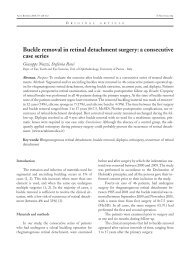Short reports+frontesp96-98 - Acta Bio Medica Atenei Parmensis
Short reports+frontesp96-98 - Acta Bio Medica Atenei Parmensis
Short reports+frontesp96-98 - Acta Bio Medica Atenei Parmensis
You also want an ePaper? Increase the reach of your titles
YUMPU automatically turns print PDFs into web optimized ePapers that Google loves.
118 <strong>Short</strong> Reports<br />
tients (77%) the diameter of parietal defect was less then<br />
6 cm. The anaesthetic technique of choice was local<br />
anaesthetic infiltration in 42 (87.5%) patients and a light<br />
intravenous sedation added in six particularly anxious patients.Through<br />
a semilunar under umbilical skin incision<br />
the margins of the sac were freed from the edges of the<br />
defect and a space was made in the pro-peritoneal space<br />
to accommodate a little sample of polypropylene net<br />
which exceeds almost of two centimetres the edge of hernial<br />
defect. A 24 hours aspiration drainage has been utilized<br />
in 13 (27%) cases. Results: Follow-up has a 30<br />
months period of observation and at the moment recurrences<br />
are not reported. Among the complications only 1<br />
(2%) seroma which required needle aspiration postoperative<br />
pain was mild and required hospital analgesia in only<br />
9 (18.75%) of cases and domiciliary analgesia in 15<br />
(31.2%), but that has not prevented a precocious and correct<br />
deambulation. No patient had severe postoperative<br />
pain. Dehospitalization has taken place within 48 hours.<br />
Conclusions: The matured experience with the use of<br />
prothesis in the hernial surgery has persuaded us to extend<br />
the indications also to the treatment of umbilical<br />
hernia and the use of prosthetic nets becomes a fundamental<br />
therapeutic stage and perhaps an important answer<br />
to a request of health service which are always more<br />
demanding in terms of: security, relapse and rapid recovery<br />
with a minimum pain.<br />
Classification and therapeutic protocol of the<br />
recurrent groin and crural hernia<br />
P. Sorrentino, A. Lenta, C. Rispoli, N. Rocco, B. Amato<br />
Department of General Surgery, Geriatrics, Oncology and Advanced<br />
Technologies, University of Naples “Federico II”, Naples,<br />
Italy<br />
Objective: In the surgical of hernias,recurrences have<br />
always represented one of the principal parameters<br />
for measuring the effectiveness of one technique in<br />
comparison with others. Managment of recurrences,<br />
whether single or multiple, is difficult, both technically<br />
and because of its psychological repercussions for the<br />
patient.The Authors report a personal and original<br />
classification of the inguinal and crural recurrent hernia,<br />
granting to the surgeon a correct frame of this<br />
pathology, addressing him to the choice of the most<br />
suitable surgical and anaesthesiological technique. Materials<br />
and methods: From January 2000 to January 2005,<br />
in the General Surgery Institute of the University of<br />
Naples “Federico II”, 1150 hernioplasties have been<br />
performed, in 1084 patients; in 230 cases we faced recurrent<br />
herniae. Examining our casuistics as to the recurrences,<br />
180 cases were inguinal herniae and 50 cases<br />
were crural herniae. For the surgical treatment of recurrent<br />
herniae, in 23 cases we preferred an anterior approach<br />
according the Lichtenstein’s technique, in 140<br />
cases we preferred a preperitoneal approach according<br />
the Trabucco’s technique, in 67 cases we preferred the<br />
Stoppa’s technique. Results: From our clinical experience,<br />
we pointed out how the laparotomic treatment of<br />
the recurrent herniae must be personalized on each patient,<br />
considering all those aspects which make each<br />
hernia different one from another. We think, infact, the<br />
choice of the surgical technique must consider a wider<br />
clinical evaluation basing on 5 parameters: the kind of<br />
the hernial defect,the dimensions of the hernial defect,<br />
the plurirecurrence; the reducibility; the somatic characteristic<br />
of patient. So, we have create a recurrent herniae<br />
classification; type 1 (first inguinal recurrent hernia,<br />
“obliquus external, reducible, small dimension



